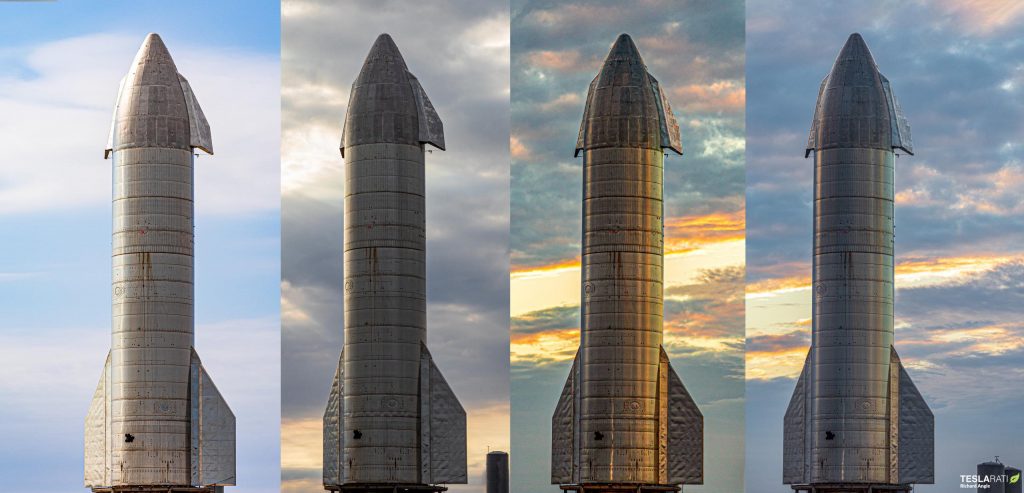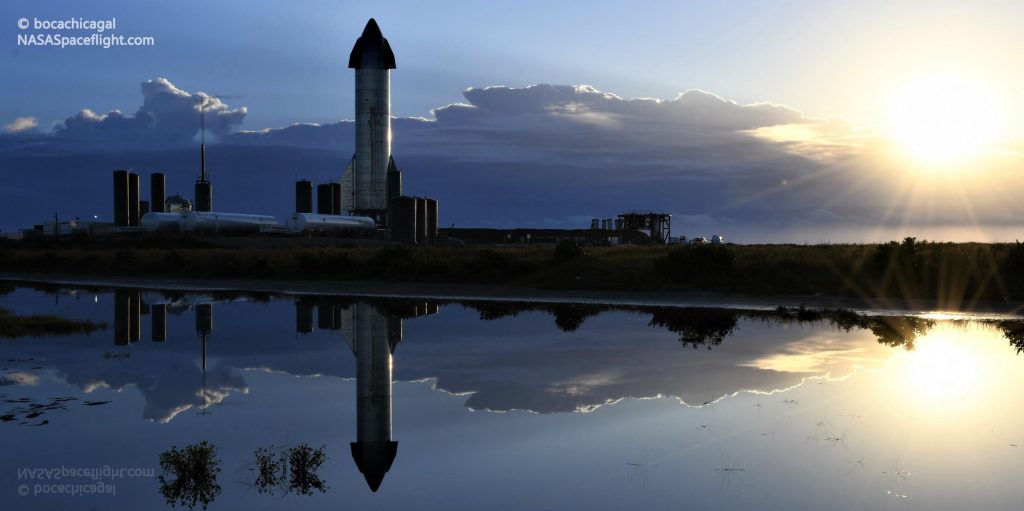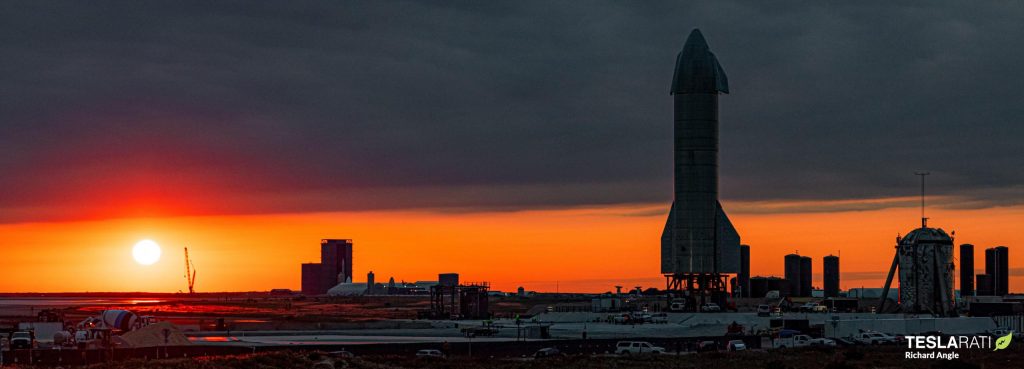

News
SpaceX confirms Tuesday Starship launch debut will have an official webcast
Update: SpaceX has confirmed plans to attempt Starship serial number 8’s (SN8) high-altitude launch debut as early as Tuesday morning, December 8th.
The company also made good on CEO Elon Musk’s promise to share SN8’s risky first flight “warts and all” and reiterated that the mission will have an official webcast. As with all developmental testing, timing is uncertain and liable to change at the last second, but Starship SN8’s launch debut is currently scheduled between 8 am and 5 pm CST (UTC-6) on Tuesday, December 8th.
SpaceX’s much-anticipated Starship launch debut has slipped from Sunday to Tuesday around the same time as CEO Elon Musk was seen arriving in South Texas.
Heralding something, the executive’s private jet landed in Brownsville, Texas on December 5th, around half a day prior to Starship SN8’s Monday, December 6th launch target. Most recently scheduled (however tenuously) as early as November 30th, there were strong signs – at one point – that SN8’s launch debut could come as soon as October or early November.

While at first quite smooth, the ~50-meter-tall (~165 ft) rocket – both the first to reach that height and fire up multiple Raptor engines – has had a fairly rocky journey from factory to flight. Unspecified issues with one or more Raptors triggered an engine swap retesting at a cost of a week or two, while the most significant issue – a near-catastrophic loss of hydraulic control caused by debris kicked up by Raptor – likely delayed SN8’s launch debut by another two or so weeks.


On November 25th, SpaceX essentially redid the ill-fated static fire after replacing a Raptor, firing up all three of Starship SN8’s engines for the second time in a prelude to the rocket’s imminent liftoff. Musk quickly confirmed that the results of the test were good, opening the door for a launch debut as early as “next week” (Nov 29/30).
November 30th soon came and went, as did backup attempts in the days following. Most recently, plans for SN8 to launch on December 6th or 7th were canceled in favor of the 8th (8 am to 5:30 pm CST/UTC-6) with backups on December 9th and 10th (8 am to 5 pm). Local road closures were quickly followed by Temporary Flight Restrictions (TFRs) published by the FAA, confirmation that they were the new targets for Starship SN8’s 12.5-kilometer (~7.8 mi) launch debut.

With Musk himself now on the ground in Texas to (presumably) oversee Starship SN8’s debut, the odds of launch later this week are arguably much better. Having now spent more than 10 weeks at the launch pad, at least twice as long as any Starship preceding it, there’s no small chance that SN8 – the first prototype of its kind – is starting to be more of a nuisance than an asset. By all appearances, Starship SN9 – essentially a “refined” copy of SN8 – is practically ready for launch with SN10 perhaps just a week or two behind it.
In other words, if SN8 (and not Raptor or ground support equipment) is specifically to blame for about a month of delays, new and improved replacements are waiting for their turn just down the road. Stay tuned for updates as we (hopefully) track towards Starship’s first high-altitude test flight.

Elon Musk
Elon Musk’s X will start using a Tesla-like software update strategy
The initiative seems designed to accelerate updates to the social media platform, while maintaining maximum transparency.

Elon Musk’s social media platform X will adopt a Tesla-esque approach to software updates for its algorithm.
The initiative seems designed to accelerate updates to the social media platform, while maintaining maximum transparency.
X’s updates to its updates
As per Musk in a post on X, the social media company will be making a new algorithm to determine what organic and advertising posts are recommended to users. These updates would then be repeated every four weeks.
“We will make the new 𝕏 algorithm, including all code used to determine what organic and advertising posts are recommended to users, open source in 7 days. This will be repeated every 4 weeks, with comprehensive developer notes, to help you understand what changed,” Musk wrote in his post.
The initiative somewhat mirrors Tesla’s over-the-air update model, where vehicle software is regularly refined and pushed to users with detailed release notes. This should allow users to better understand the details of X’s every update and foster a healthy feedback loop for the social media platform.
xAI and X
X, formerly Twitter, has been acquired by Elon Musk’s artificial intelligence startup, xAI last year. Since then, xAI has seen a rapid rise in valuation. Following the company’s the company’s upsized $20 billion Series E funding round, estimates now suggest that xAI is worth tens about $230 to $235 billion. That’s several times larger than Tesla when Elon Musk received his controversial 2018 CEO Performance Award.
As per xAI, the Series E funding round attracted a diverse group of investors, including Valor Equity Partners, Stepstone Group, Fidelity Management & Research Company, Qatar Investment Authority, MGX, and Baron Capital Group, among others. Strategic partners NVIDIA and Cisco Investments also continued support for building the world’s largest GPU clusters.
News
Tesla FSD Supervised wins MotorTrend’s Best Driver Assistance Award
The decision marks a notable reversal for the publication from prior years, with judges citing major real-world improvements that pushed Tesla’s latest FSD software ahead of every competing ADAS system.

Tesla’s Full Self-Driving (Supervised) system has been named the best driver-assistance technology on the market, earning top honors at the 2026 MotorTrend Best Tech Awards.
The decision marks a notable reversal for the publication from prior years, with judges citing major real-world improvements that pushed Tesla’s latest FSD software ahead of every competing ADAS system. And it wasn’t even close.
MotorTrend reverses course
MotorTrend awarded Tesla FSD (Supervised) its 2026 Best Tech Driver Assistance title after extensive testing of the latest v14 software. The publication acknowledged that it had previously criticized earlier versions of FSD for erratic behavior and near-miss incidents, ultimately favoring rivals such as GM’s Super Cruise in earlier evaluations.
According to MotorTrend, the newest iteration of FSD resolved many of those shortcomings. Testers said v14 showed far smoother behavior in complex urban scenarios, including unprotected left turns, traffic circles, emergency vehicles, and dense city streets. While the system still requires constant driver supervision, judges concluded that no other advanced driver-assistance system currently matches its breadth of capability.
Unlike rival systems that rely on combinations of cameras, radar, lidar, and mapped highways, Tesla’s FSD operates using a camera-only approach and is capable of driving on city streets, rural roads, and freeways. MotorTrend stated that pure utility, the ability to handle nearly all road types, ultimately separated FSD from competitors like Ford BlueCruise, GM Super Cruise, and BMW’s Highway Assistant.
High cost and high capability
MotorTrend also addressed FSD’s pricing, which remains significantly higher than rival systems. Tesla currently charges $8,000 for a one-time purchase or $99 per month for a subscription, compared with far lower upfront and subscription costs from other automakers. The publication noted that the premium is justified given FSD’s unmatched scope and continuous software evolution.
Safety remained a central focus of the evaluation. While testers reported collision-free operation over thousands of miles, they noted ongoing concerns around FSD’s configurable driving modes, including options that allow aggressive driving and speeds beyond posted limits. MotorTrend emphasized that, like all Level 2 systems, FSD still depends on a fully attentive human driver at all times.
Despite those caveats, the publication concluded that Tesla’s rapid software progress fundamentally reshaped the competitive landscape. For drivers seeking the most capable hands-on driver-assistance system available today, MotorTrend concluded Tesla FSD (Supervised) now stands alone at the top.
News
Elon Musk’s Grokipedia surges to 5.6M articles, almost 79% of English Wikipedia
The explosive growth marks a major milestone for the AI-powered online encyclopedia, which was launched by Elon Musk’s xAI just months ago.

Elon Musk’s Grokipedia has grown to an impressive 5,615,201 articles as of today, closing in on 79% of the English Wikipedia’s current total of 7,119,376 articles.
The explosive growth marks a major milestone for the AI-powered online encyclopedia, which was launched by Elon Musk’s xAI just months ago. Needless to say, it would only be a matter of time before Grokipedia exceeds English Wikipedia in sheer volume.
Grokipedia’s rapid growth
xAI’s vision for Grokipedia emphasizes neutrality, while Grok’s reasoning capabilities allow for fast drafting and fact-checking. When Elon Musk announced the initiative in late September 2025, he noted that Grokipedia would be an improvement to Wikipedia because it would be designed to avoid bias.
At the time, Musk noted that Grokipedia “is a necessary step towards the xAI goal of understanding the Universe.”
Grokipedia was launched in late October, and while xAI was careful to list it only as Version 0.1 at the time, the online encyclopedia immediately earned praise. Wikipedia co-founder Larry Sanger highlighted the project’s innovative approach, noting how it leverages AI to fill knowledge gaps and enable rapid updates. Netizens also observed how Grokipedia tends to present articles in a more objective manner compared to Wikipedia, which is edited by humans.
Elon Musk’s ambitious plans
With 5,615,201 total articles, Grokipedia has now grown to almost 79% of English Wikipedia’s article base. This is incredibly quick, though Grokipedia remains text-only for now. xAI, for its part, has now updated the online encyclopedia’s iteration to v0.2.
Elon Musk has shared bold ideas for Grokipedia, including sending a record of the entire knowledge base to space as part of xAI’s mission to preserve and expand human understanding. At some point, Musk stated that Grokipedia will be renamed to Encyclopedia Galactica, and it will be sent to the cosmos.
“When Grokipedia is good enough (long way to go), we will change the name to Encyclopedia Galactica. It will be an open source distillation of all knowledge, including audio, images and video. Join xAI to help build the sci-fi version of the Library of Alexandria!” Musk wrote, adding in a later post that “Copies will be etched in stone and sent to the Moon, Mars and beyond. This time, it will not be lost.”








